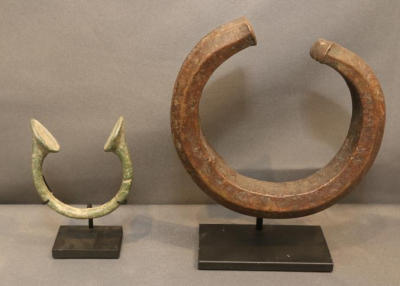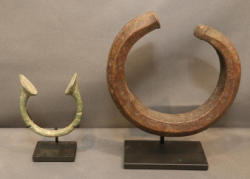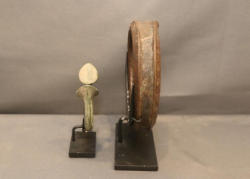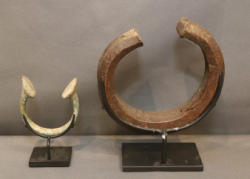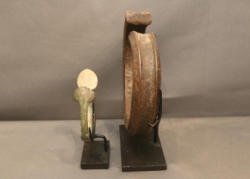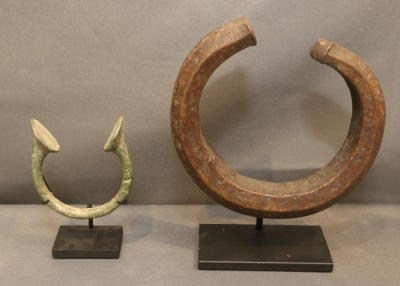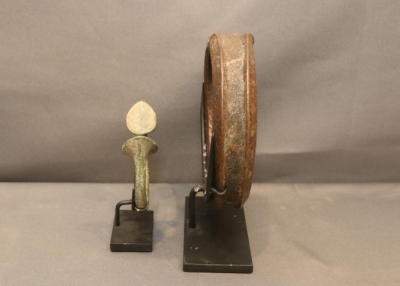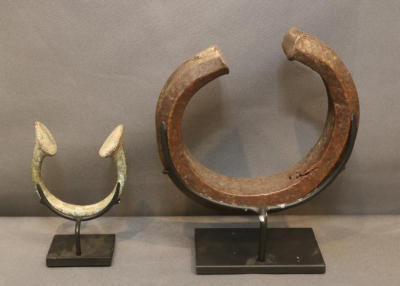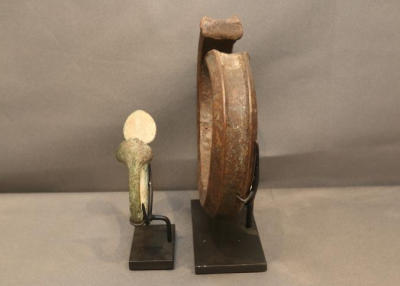Items located in Pleasant Valley, NY. Items include wall plaque from the royal palace, Edo people, Benin; rare masterwork ceremonial ax, Sapo-Sapo/Songye people, Congo; prestige neck ring, Kirdi or Fali people, Nigeria; West African anklet and bracelet bells; late 19thC gold weights, Akan people; and more.
AFRICAN ART COLLECTION OF MARY SUE AND PAUL PETER ROSEN
Mary Sue and Paul Peter Rosen have collected African art for over thirty years, making nine trips to Africa to study the art in its cultural setting. The Rosens have published three African art books, curated more than ten exhibitions from their collection, and have given public lectures about African art and culture. They have donated art from their collection to various institutions including the Newark Museum, Temple University in Philadelphia, the SMA Fathers African Art Museum in Tenafly, New Jersey, and the African American Research Library in Fort Lauderdale, Florida.
Payment is due by Monday, June 3 at 1PM.
Pickup in Pleasant Valley, NY must be completed by Monday, June 3 at 3PM.
All lots sold as is, where is. There is a 15% Buyers Premium for all lots purchased. Payment methods include cash, MC, Visa, Discover or good check. You can make credit card payment online by going to your Member Area and selecting your invoice.
*NOTE* Shipping is available on all items.
AFRICAN ART COLLECTION OF MARY SUE AND PAUL PETER ROSEN
Mary Sue and Paul Peter Rosen have collected African art for over thirty years, making nine trips to Africa to study the art in its cultural setting. The Rosens have published three African art books, curated more than ten exhibitions from their collection, and have given public lectures about African art and culture. They have donated art from their collection to various institutions including the Newark Museum, Temple University in Philadelphia, the SMA Fathers African Art Museum in Tenafly, New Jersey, and the African American Research Library in Fort Lauderdale, Florida.
Payment is due by Monday, June 3 at 1PM.
Pickup in Pleasant Valley, NY must be completed by Monday, June 3 at 3PM.
All lots sold as is, where is. There is a 15% Buyers Premium for all lots purchased. Payment methods include cash, MC, Visa, Discover or good check. You can make credit card payment online by going to your Member Area and selecting your invoice.
*NOTE* Shipping is available on all items.
Auction Info
Items located in Pleasant Valley, NY. Items include wall plaque from the royal palace, Edo people, Benin; rare masterwork ceremonial ax, Sapo-Sapo/Songye people, Congo; prestige neck ring, Kirdi or Fali people, Nigeria; West African anklet and bracelet bells; late 19thC gold weights, Akan people; and more.
AFRICAN ART COLLECTION OF MARY SUE AND PAUL PETER ROSEN
Mary Sue and Paul Peter Rosen have collected African art for over thirty years, making nine trips to Africa to study the art in its cultural setting. The Rosens have published three African art books, curated more than ten exhibitions from their collection, and have given public lectures about African art and culture. They have donated art from their collection to various institutions including the Newark Museum, Temple University in Philadelphia, the SMA Fathers African Art Museum in Tenafly, New Jersey, and the African American Research Library in Fort Lauderdale, Florida.
Payment is due by Monday, June 3 at 1PM.
Pickup in Pleasant Valley, NY must be completed by Monday, June 3 at 3PM.
All lots sold as is, where is. There is a 15% Buyers Premium for all lots purchased. Payment methods include cash, MC, Visa, Discover or good check. You can make credit card payment online by going to your Member Area and selecting your invoice.
*NOTE* Shipping is available on all items.
AFRICAN ART COLLECTION OF MARY SUE AND PAUL PETER ROSEN
Mary Sue and Paul Peter Rosen have collected African art for over thirty years, making nine trips to Africa to study the art in its cultural setting. The Rosens have published three African art books, curated more than ten exhibitions from their collection, and have given public lectures about African art and culture. They have donated art from their collection to various institutions including the Newark Museum, Temple University in Philadelphia, the SMA Fathers African Art Museum in Tenafly, New Jersey, and the African American Research Library in Fort Lauderdale, Florida.
Payment is due by Monday, June 3 at 1PM.
Pickup in Pleasant Valley, NY must be completed by Monday, June 3 at 3PM.
All lots sold as is, where is. There is a 15% Buyers Premium for all lots purchased. Payment methods include cash, MC, Visa, Discover or good check. You can make credit card payment online by going to your Member Area and selecting your invoice.
*NOTE* Shipping is available on all items.
Categories:
Previous
|
EUROPEAN AND CONGOLESE MANILLAS. Although Europeans brought large numbers of manillas to Africa, they were also produced as ingots by a number of African tribes who used them for trade among themselves. There is considerable evidence that the existence of manillas in West Africa predated the arrival of Europeans. (A) Birmingham bracelet-form manilla from Birmingham England. Mainly traded in Nigeria. The U-shaped form with large flared feet was greatly prized. Smooth surfaces typical of a European manilla. Late 1800s. On custom base. Copper alloy. H3in. (B) Onganda ring-shaped manilla. Jonga (Onga) people, Congo. Two facets on either side are separated by a wide, flat, shallow channel. The ends are slightly flared by hammering. Given as part of bride price (marriage dowry). The uneven surfaces are typical of manillas created in Africa. Mid-1800s. On custom base. Copper. H4.5in.
More Details
EUROPEAN AND CONGOLESE MANILLAS. Although Europeans brought large numbers of manillas to Africa, they were also produced as ingots by a number of African tribes who used them for trade among themselves. There is considerable evidence that the existence of manillas in West Africa predated the arrival of Europeans. (A) Birmingham bracelet-form manilla from Birmingham England. Mainly traded in Nigeria. The U-shaped form with large flared feet was greatly prized. Smooth surfaces typical of a European manilla. Late 1800s. On custom base. Copper alloy. H3in. (B) Onganda ring-shaped manilla. Jonga (Onga) people, Congo. Two facets on either side are separated by a wide, flat, shallow channel. The ends are slightly flared by hammering. Given as part of bride price (marriage dowry). The uneven surfaces are typical of manillas created in Africa. Mid-1800s. On custom base. Copper. H4.5in.
High Bid:
$130.00 – bullish13
Auction Type: One Lot
Quantity: 1
Bidding has closed on this lot

